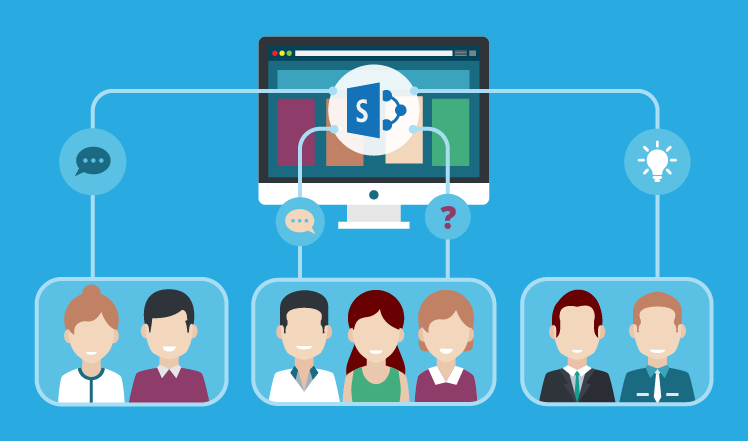Crossing Organizational Borders With a SharePoint Collaboration Site
Developing a SharePoint-based solution for content or workflow management, companies take lesser risks of its poor adoption as it’s about helping users to manage their daily duties. Sleek performance, easy navigation and integration with enterprise systems can usually ensure the solution’s buy-in.
But as soon as a company decides to implement SharePoint for collaboration needs, there comes a waterfall of challenges. What is more important: interface or functionality? Which features are necessary? How to retain users’ satisfaction? How to ensure cross-team collaboration and engage specialists from different teams? The questions swarm around SharePoint and make the project’s prospects hazy.
To address these challenges, we suggest considering the concept of a dedicated SharePoint collaboration site as the key to successful collaboration and knowledge generation.

Why a collaboration site?
One of the common mistakes causing SharePoint failure usually lies in the initially incorrect approach to developing a collaboration solution. Non-customized out-of-the-box tools have no chances to gain users’ affection and incite employees to actively use them. A fruitful collaboration can only exist in the heart of a forum-like full-fledged solution, such as a SharePoint collaboration site that serves as:
A single source of information. A site allows to perform tasks via a unified collaboration platform and share valuable information with colleagues instead of just storing it on PCs, in the cloud or even on paper. It also enables employees to accumulate important work-related information in one location and reuse it at any time.
A corporate knowledge base. A collaboration site gives the opportunity to broaden a corporate knowledge base that can be used to accumulate data on a company’s current activities, to conduct market research on new business areas and opportunities, as well as to educate new team members in order to facilitate and shorten their introduction period.
A unified discussion hub. A site is a great tool that enables employees to instantly discuss business issues without disrupting their personal timetables with lengthy meetings. Posted opinions and ideas will never be lost and can be revised or elaborated further whenever a team needs it.
At the same time, to achieve success while using a SharePoint collaboration site, you will face three major challenges: to manage large volumes of content, to assign user roles and to win employees’ loyalty to the site.
Taming the content
As the concept of a collaboration site is built around publishing information, employees will have to deal with large amounts of content. The site should offer the possibilities to easily publish new materials and to sift it out in order to prevent the site from becoming a data dump.
Content publishing features can help employees to make posts on the collaboration site in a unified style. Fortunately, SharePoint provides an embedded HTML-editor that covers the whole range of functions from text formatting to inserting files and pictures. The objective is to let users edit and publish their content on their own and make it readable and easy-to-understand for other community members.
Content moderation features aim to minimize the risk of a site’s ‘informational pollution’ and give the green light to valuable and relevant data. Additionally, we recommend to assign a content moderator responsible for content filtering. This way, every post draft will first go to the site’s moderator and will be published only after his / her approval. It’s also possible to create a rating scale to assess every publication from irrelevant to top important. This is how every post will have a rate enabling users to find the most valuable content easier.
Both content management and content moderation rules can be described in detail and placed in a separate content guide tab to let employees consult the guidelines at any time.
Assigning user roles
In order to ensure a transparent user structure, it’s advisable to foresee at least 3 groups of users provided with relevant permissions according to their role on the site, in order to ensure the site’s optimal functioning and prevent chaotic site management.
Observers. These are users who aren’t team members and don’t participate in team collaboration actively but want to follow the community, see new publications and expand their knowledge on a particular issue. This role doesn’t allow to publish any content but permits to access the collaboration site, read posts and search for information. Whenever an observer wants to join the community, he or she will have to apply.
Contributors. All the active team members who regularly add content and participate in the discussions can be called contributors. This group of users should be able to make new publications, edit them and leave comments. Contributors are also provided with personal pages that they can use as their personal knowledge boards.
Moderators. Depending on a team size, a collaboration site can have one or several moderators. A moderator is a user with the most extensive permissions allowing to evaluate others’ publications, reject a post if it doesn’t meet the requirements of the content guide, rate posts and participate in the development of the site by adding new topics and subtopics.
Keeping employees engaged
Another challenging task while working with a SharePoint collaboration site is to motivate all the team members to use it in order to develop a centralized knowledge baseregularly. There are a few features that will help to stimulate user activity.
‘User catchers’. To hook the community’s attention, ‘user catchers’ can be created. It might be a system of automatic notifications that will inform users on every new publication or weekly updates made on their collaboration site. This could invite them to enter the site and participate in the discussion, ensuring their better awareness of the content.
- New post notification can be sent to work group members to let them view the latest changes to the site. The notification can include a ‘Read’ button containing the direct link to a new publication.
- Weekly summary notification will notify all the site members about the posts added during the past week. The notification can provide the direct link to the general newsfeed with the latest posts first.
Personal ratings. By evaluating content, a moderator guarantees the relevance and the value of every post that appears on the site. The system of an automatic personal rating can be also introduced to determine the most active members, e.g. to rate best publishers of the week or of the month in order to let the team see the most active contributors. For more passive team members, it will be reasonable to introduce a dynamic chart that will show their own activity progress throughout different timeframes (e.g. weeks, months or quarters).
Personal pages. A strict moderation that prevents the site from clogging implies that a number of posts will be sifted out. But what could you do if a team member wants to keep a post containing important information that is too specific for the rest of the community? To publish posts with no previous moderation, employees can be provided with their personal pages that will give them more freedom, will let them store all the information they need in one place and share it with other members even if it’s not published in the general newsfeed.
Custom design. Last but not least, custom design is actually what a collaboration site cannot succeed without. A site should give the sense of belonging to a community and reflect the domain users are working in. Custom design isn’t an option in this case, it’s a must that will help to increase user acceptance significantly. We encourage companies to spend some efforts on creating a custom master page, as well as a few templates for subsites, which will help to visualize the general concept (e.g. if your team specializes in healthcare, create pages with ‘healthy’ design).
Choosing a development course
Implementing SharePoint collaboration at an enterprise isn’t an easy task. Any attempts to deliver an out-of-the box solution won’t work, as the risk of rejection is too high. Moreover, even a feature-rich solution can also fail if it doesn’t meet users’ needs.
The development course should be designed with employees’ expectations in mind. When taking up a SharePoint collaboration project, start with drawing a portrait of the future user and describing their information needs, then think together with a SharePoint consultant about how the site can become an integral part of the users’ working days.
Give us feedback
We are looking forward to hearing about your experience of adopting SharePoint-based collaboration solutions. What were the pitfalls of implementing such a solution at your organization? Which features are considered the most popular and proved to help with user engagement? What do you think are the ways to make SharePoint collaboration projects more successful?

